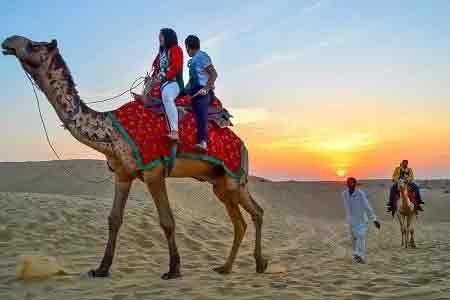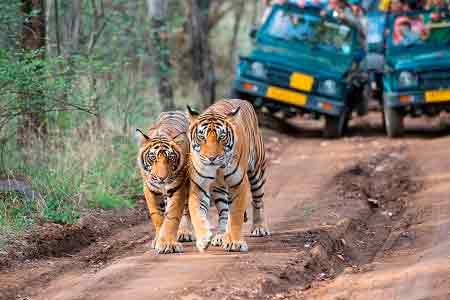

Mount Abu is a popular hill station in the Aravalli Range in Sirohi district of Rajasthan state in western India, near the border with Gujarat. The mountain forms a distinct rocky plateau 22 km long by 9 km wide. The highest peak on the mountain is Guru Shikhar at 1,722 m (5,650 ft) above sea level. It is referred to as 'an oasis in the desert' as its heights are home to rivers, lakes, waterfalls and evergreen forests. The nearest train station is Abu Road railway station: 28 km away.
Nakki Lake
Located at the heart of Mount Abu, Nakki Lake is the first manmade lake in India. 11,000 meters deep and about a quarter of a mile wide, a trip to Mount Abu is considered incomplete without visiting Nakki Lake. A number of legends surround the origin of the lake, including one that states that Nakki Lake is said to be a sacred lake for the proud Garacia Tribe; but the fact is undeniable that a visit to this place brings you close to the beauty of nature and serenity. As you take a boat ride over the tranquil waters, you can gaze at the mesmerizing hills, the interestingly shaped rocks, and the lush greenery that surrounds the lake. It was the Nakki Lake where Mahatma Gandhi’s ashes were immersed back in 1948 and the Gandhi Ghat was constructed nearby, that’s all the more reason to visit this place. From nature lovers to photographers, the Nakki Lake has clean blue waters and beautiful surroundings that add to the romantic element of the lake, making it a must visit destination for everyone.
Guru Shikhar
Guru Shikhar is one of the peaks of the Aravalis, which has the honor of not only being the highest point in Mount Abu, but in the entire Aravali Range. Standing at 1722 meters above sea level, Guru Shikhar is a must visit destination in Mount Abu for the amazing panoramic views it offers of Mount Abu and the surrounding Aravalis, and also for spiritual reasons. Right before you reach the peak, you will find a temple dedicated to Dattatreya, who is believed to be the son that was given to the sage Atri and his wife Anasuya by the holy trinity, Brahma, Vishnu, and Shiva. The peak itself is dedicated to Dattatreya and the temple, dedicated to Lord Vishnu, is an important pilgrimage point for Vaishnavites. Right near the peak is another temple, this one dedicated to Ahilya. On the peak, there is also a huge bell with ‘1141 AD’ inscribed on it. While the original bell had begun to disintegrate and was replaced by a newer bell, its tones are still very captivating and reach a long distance. It is a common practice among visitors to head the peak to try and ring the bell as hard as they can, only to witness the sound-filled serenity in it.
Toad Rock View Point
Known for being surrounded by a number of strangely shaped rocks, Nakki Lake offers numerous photo ops to visitors. One of the most popular destinations near Nakki Lake however, has to be the Toad Rock View Point. Located on the main trekking trail near the Lake, the Toad Rock has often been referred to as the mascot of Mount Abu. The massive rock structure is an excellent illustration of igneous rocks found in amazing shapes and is shaped, as the name suggests, like a toad. One of the most frequented places in the hill station; people visit this place out of sheer curiosity. It is pretty easy to climb the rock and the views that it offers of the Nakki Lake and the surrounding greenery are unparalleled. Apart from the novelty of the rock itself, the breathtaking scenery from atop just adds to whole experience, making it well worth your while.
Dilwara Jain Temple
The Dilawara Jain Temple in Mount Abu is considered to be one of the most beautiful Jain pilgrimage sites in the entire world. While it looks like a basic temple from the outside, when you enter, you can marvel at the extraordinary architecture and the marvelous stone carvings that grace the temple. The interiors of the temple truly showcase craftsmanship at its best. Built between the 11 th and the 13 th centuries AD, the temples display intricately carved ceilings and pillars that won’t fail to inspire you. Surrounded by lush green hills, the ambiance of serenity and peace at the Dilwara Temples is unparalleled. The temple is divided into 5 sections, namely: 1. Shri Mahaveer Swami Temple: Constructed in 1582, this temple is devoted to Lord Mahaveer, the 24th Tirthankara of Jain's. 2. Shri AdiNath Temple/Vimal Vasahi Temple: Built by Vimal Shah, the Minister of the Solanika ruler of Gujarat in 1031 A.D., this is the oldest temple of all, and is dedicated to Shri Adinath Ji, the first Jain Trithankara. 3. Shri ParshavNath Temple/Khartar Vasahi Temple: Built by the Mandika clan in between 1458-59 A.D., this temple features a tall pinnacle along with four big Mandapas. 4. Shri Rishabdaoji Temple/Peethalhar Temple: Most of the statues here are built using ‘Pittal’ (Brass), and has been built by Bhima Shah, a minister from the Gujarat dynasty. 4. Shri Nemi Nath Ji Temple/Luna Vasahi Temple: Built in 1230 A.D. by two brothers, Tejpal and Vastupal, this temple is dedicated to the 22nd Tirthankara of Jainism - Shri Nemi Nathji. Open every day from 12.00 pm to 5.00 pm, the temple is open to all, and is quite an exquisite sight to behold when in Mount Abu.
Mount Abu Sanctuary
There is hardly any dearth of wildlife sanctuaries in Rajasthan, and among them is this gem named the Mount Abu Sanctuary. Located across the oldest hill range in the country, the Aravalis, the sanctuary covers a huge area, and is home to a rich variety of wildlife. From the flora, fauna, and the avian species that can be seen here to the breathtaking views and sceneries offered, as well as the eco-tourism opportunities, the sanctuary is definitely a favorite among the many visitors to Mount Abu. The vegetation starts from being sub-tropical thorn forests at the foothill region, and varies up to sub-tropical evergreen forests at higher altitudes. Home to a number of rare and endangered species of animals, the sanctuary houses leopards, jungle cats, sambhar, wolves, Indian civets, hyenas, Indian foxes, jackals, bears, wild boars, common langurs, pangolins, Indian hares, mongoose, hedgehogs, and porcupines, among others. With the presence of over 250 avian species, the sanctuary also makes for an amazing destination for bird watchers.
Lal Mandir Mount Abu
Located on Delwara Road, near the Delwara Jain Temple, is this small temple dedicated to Lord Shiva. The temple offers a very peaceful ambiance and is considered as one of the most ancient holy places located in Mount Abu. A small and beautiful temple, the Lal Mandir gets its name from the fact that all the walls of the temple have been painted red. The temple is one of the must visit spots in Mount Abu, popular among the religious tourists as well as others. The temple is also quite well-known for being a Swayambhu ‘ Shiva Temple, so named because the idol placed inside the temple can be seen wearing a ‘jenau’.
Trevors Tank Mount Abu
Trevor’s tank, a crocodile park, is a manmade crocodile breeding spot which is located at a distance of about 5 kilometres from Mount Abu. The spot offers amazing scenic beauty and a great spot for crocodile, bird, and other wildlife (like the black bear) sightings. The lush green surroundings make it quite a popular picnic spots that is always worth a visit. Trevor’s Tank is a small but pristine ecosystem for crocodiles, and creates a unique blend between manmade creations and the natural environment. Being located at a hill station, Trevor’s Tank can be visited all throughout the year, owing to the mild weather it enjoys all the time. However, it might be a good idea to avoid the monsoon season, as that may hinder your explorations slightly. Whether you are a shutterbug or want to watch some birds or other wildlife, Trevor’s Tank is a destination to add on your Mount Abu bucket-list.
Peace Park Mount Abu
Nestled in between two famous Aravali peaks, the Guru Shikhar and Achalgarh, the Peace Park in Mount Abu is a part of the Brahma Kumaris’ establishment. With an ambiance that creates the perfect blend of serenity and tranquillity, the park offers a beautiful backdrop for silence and peaceful recreation. At the Peace Park, one can visit the rock garden that houses a wide variety of Cactaceae, the orchard, citrus corner, and view the numerous floral displays that include coleus, shrubs, hibiscus, creepers and climbers, and an exquisitely beautiful rose garden. The park also has a number of areas, like a stone cave and huts, where people can meditate in a tranquil environment. The Brahma Kumaris also provide a guided tour of the park, and you can also watch a short video film that explains interesting meditation concepts. This place of solitude in the lap of nature is something you must experience.




































Rajasthan Tour Packages are arguably the most sought after holiday packages in India. The very name Rajasthan conjures up the image of hill top fortresses, maharajas with scimitars riding the painted elephants, the exquisitely carved havelis. Our Rajasthan tour packages the camel safari in the sam sand dunes of Thar in Jaisalmer and Bikaner to the abundant wildlife of Ranthambore and Bharatpur, Explore the World Heritage Hill Forts of Rajasthan, marvel at the frescoes and havelis, have a wild run at Ranthambore or shop till you drop at the vibrant bazaars in Jaipur, Jodhpur and Udaipur and not to mention the planets biggest cattle fair in Pushkar.